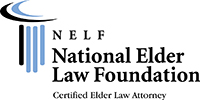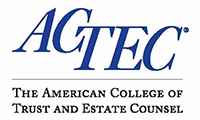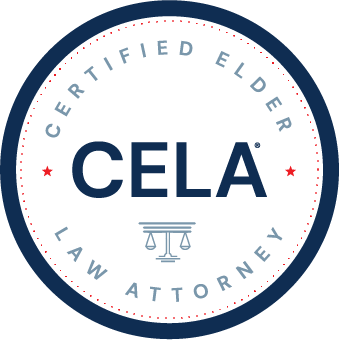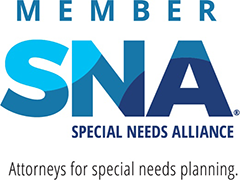Transfers of a home are often motivated by a desire to put control of the home in the hands of a person competent to handle it, and also to avoid later Medicaid estate recovery. Nevertheless, such transfers always raise tax questions, including capital gains taxes, real property taxes, and estate and gift taxes. In addition, there are other ownership considerations such as freedom of later disposition, creditor rights, and right to rents. Finally, home transfers always have implications for Medicaid estate recovery.
At present, the State of Colorado does not file estate claims for medical assistance on life estates, joint tenancies and other non-probate assets. As such, clients should be counseled on the best way to transfer ownership of a home for assets protection purposes. A person's home is usually their most valuable asset and any transfer to a family member most minimize the risk of the home from being subject to the family member's creditors or marital problems. A transfer of the home to a family member in joint tenancy, a life estate remainder interst transfer or transferring the entire interest in the home and signing a lifetime occupancy agreement all have there pros and cons. A beneficiary deed will disqualify a home owner from ever receiving Meidcaid services. The home owner must consult with a certified elder law attorney before making any transfer of the home.
Other Factors to Consider before Conveying the Home
Obviously, it will be important for the attorney to advise the client regarding the risk associated with the transfer of the home. These risks include subjecting the property to the donee's creditors, divorce proceedings, IRS liens, and the need to maintain cooperation among all the donees with regard to repairs, maintenance and any future disposition of the property. In addition, beginning on or after 2002 qualifying Colorado seniors may be exempt for all or part of their real property tax (See C.S.R. 39-3-101 to 208). The exemption reduces the taxable value of the home by 50% of the first $200,000 for a qualifying residence. To qualify the owner-occupier must be 65 years of age or older as of the assessment date and has occupied such residential property as his or her primary residence for the ten years preceding the assessment date.
Transfer of Home to a Spouse.
It is often advisable for an institutionalized spouse to transfer his or her interest in a home to the community spouse. This is to avoid estate recovery after the death of the institutionalized souse. Although this can be an issue in Colorado, the well spouse should be free to sell, borrow on, or otherwise dispose of the home after Medicaid eligibility is established for the institutionalized spouse without prejudicing the eligibility of the other spouse.
Note, however, that if the community spouse plans to sell the home, he or she must be concerned about possible capital gains taxes. A person who has owned and occupited their home two out the last five years can shelter gain up to $500,000 on a joint return but only $250,000 for a single tax payer. See discussion under Tax Rules Related to the sale of a Principal Residence.
If the community spouse continues to hold the home with the nursing home spouse as joint tenancy, and the ill spouse dies first, the community spouse will get either a full “step-up” or at least a half “step-up” in her tax basis, respectively. The only problem is that the community spouse has to be sure to die second. If the community spouse dies first, the institutionalized spouse will succeed to half of all of the home, with likely exposure to later Medicaid estate recovery claims.
Transfer of Home to children or other third parties.
Transfers to adult children could be arranged as an outright grant, a gift in trust, in joint tenancy, in fee with retained life estate, or in other ways. The job of the attorney is to make sure that the donor transfers enough rights to avoid an estate recovery claim by the State of Colorado or the assertion by the State that the donor never parted with ownership of the property. On the other hand, the donor should retain a sufficient interest to obtain a new tax basis (if one is needed or desired), under IRC § 2036(a). In other words, there is often competition between Medicaid planning and tax planning: (a person needs to divest the interest to avoid later Medicaid recovery claims, and needs to retain an interest in order to force a new tax basis at death.)
Methods of Achieving Inclusion of Assets in Donor's Gross Estate
Under Code § 2036, any type of life estate or income interest that is retained is subject to estate tax inclusion in the Donor's estate. A reservation of a life estate in a deed, even if limited to the right of occupancy, can case estate tax inclusion. Further, under § 2036(a)(2), inclusion in the federal gross estate is caused if the Donor of a trust reserves an unrestricted power, exercisable alone or in conjunction with another person, to designate the persons who will possess or enjoy the principal or income of the trust.
Under § 2038, property over which the decedent had the power to alter, amend or terminate disposition is includable in the gross estate.
Using the position of the IRS to obtain stepped-up basis.
When estate tax issues were much more of a factor, the taxpayer would argue against inclusion of the property previously conveyed prior to the decedent's death in the federal gross estate, and the IRS would argue for inclusion of the property. Now that estate taxes are much less of an issue, the roles are being reversed. You can use the IRS's prior victories to argue that your property should receive a stepped-up basis. The following are some examples
Life estate can be "retained" in deed without being "reserved."
Since an interest in an asset can be "retained' within the meaning of § 2036 without being "reserved," the Internal Revenue Service ("IRS") often takes the position that an agreement, understanding or pattern which shows that a life estate was in essence retained causes the transferred assets to be subject to estate taxation. For example, if the client's home were transferred outright, the IRS could still take the position that a life estate was retained by agreement or understanding of the parties, and often takes this position when the client continues to live there without paying fair market rent. For examples, see:
- Rev. Rul. 78-409, 1978-2 CB 234
- Estate of Hendry v. Commissioner, 62 T.C. 861 (1974)
- Guynn v. United States, 437 F.2d 1148 (4th Cir. 1971)
- Estate of duPont v. Commissioner, 63 T.C. 746 (1975)
- Estate of Linderme v. Commissioner, 52 T.C. 305 (1969)
- Rev. Rul. 70-155, 1970-1 CB 190
- Estate of Rapelje v. Commissioner, 73 T.C. 821 (1979)
- Estate of Callahan v. Commissioner, 42 TCM 362 (1981)
- Estate of Stubblefield v. Commissioner, 42 TCM 342 (1981).
Right of Occupancy
Gifts by Non-Institutionalized Donor. Under IRC 1014(a), a person acquiring property from a decedent shall take a basis for that property equal to the fair market value of the property on the date of the decedent's death or the alternative valuation date if elected. IRC 1014(b) lists ten situations in which a person will be deemed to have acquired property from a decedent (thereby causing the basis to be stepped up). § 1014(b)(9) is the catch-all category that, when read together with Sec. 1014(b), will almost certainly result in a stepped-up basis when a parent gifts the family home to a child but continues to live there.
For § 1014(b)(9) to apply, two tests have to be met. First, the property must be acquired from a decedent by reason of death, form of ownership, or other conditions. Second, acquiring the property from a decedent by reason of death, form of ownership, or other conditions must cause the property to be included in the decedent's gross estate.
Considering first the requirements that the property must be acquired from a decedent by reason of death, form of ownership, or other conditions; if a parent gifts the family home to a child, then dies, did the child really acquire the property from a decedent? Further, did the transfer take place by reason of death, form of ownership or other conditions? Fortunately, the regulations (Regs) at 1.10 14-2(b)(2) indicate that “prior to death transfers” are drawn within the scope of 1014(b)(9). In this context the Regulation Statutes that “property acquired prior to the death of a decedent which is includable in the decedent’s gross estate . . . is within the scope of this depreciable property that was previously transferred. Here the Regulations seek to cause a reduction of the new stepped-up basis provided by 1014(b)(9) in the amount that the donee has already taken on the property he/she received prior to the decedent’s death. However, the Regulations at 1.1014-2(b)(3) do limit the scope of Sec. 1014(b)(9) by excluding from stepped-up basis treatment (1) annuities described in Sec. 72 and (2) stock in foreign personal holding companies. Additionally, the Regulations provide that the stepped-up basis provisions of 1014(b)(9) do not apply to the other nine categories of property that will be respectively stepped-up under one or more of the other nine paragraphs of § 1014(b).
Turning to the second requirement of Sec. 1014(b)(9), how do we insure that the gifted home is included in the donor/parents’ gross estate? See the table of cases and rulings in Appendix that displays various fact patters where parents have transferred residential property to their children without giving up occupancy and for a sample home occupancy agreement.
An examination of the table of cases in Appendix, leads to the conclusion that having an oral understanding of continued occupancy by the parent simultaneous with the transfer of the property almost certainly will require the inclusion of the residence in the parents’ gross estate when the parent actually does not occupy the property. Such inclusion will meet the “inclusion” requirement of § 1014(b)(9) and result in a step-up in basis to reflect the property’s value at the applicable valuation date. Further, it can be seen from the table that this result can be accomplished without the necessity of an express occupancy agreement. Nor do the cases indicate that enforceability of the understanding has ever been raised as an issue in deciding in failure to file gift tax returns, (2) not paying rent to the child, and (3) the parents’ continued payment of expenses of the property.
So where does this leave us? On the theory that the first test under 1014(b)(9) discussed above is met, since the Regulations defined a gift with continued occupancy to be the kind of transfer covered by 1014(b)(9), the primary planning objective of the attorney would be to insure the inclusion of the gifted property in the decedent’s gross estate by documenting the existence of an oral unenforceable understanding of continued occupancy that was entered into simultaneously with the transfer. Such an understanding should pose no problem for Medicaid purposes since the property will have been validly transferred under state law. At the same time, given the IRS’s different definition of what constitutes a transfer for federal tax purposes, the property should be brought back into the decedent’s estate under IRC 2036 and should be afforded a market value basis under 1014(b)(9).
A Gift of Home by Institutionalized Donor.
Considering the basis issue, the donor's expression of intent to return home should be construed by IRS as a plan or understanding among the parties, wherein the donor will have retained possession or use of the property within the meaning of Sec 2036. However, in the vast majority of retained possession cases cited under Sec. 2036, the donor not only made the gift pursuant to an understanding of continued usage, but also actually did continue to use or possess the property following the gift.
Such continued use would not usually be the case for a donor who is institutionalized at the time the gift is made. Typically, such a donor would make the gift, then remain in an institution, and he would not reoccupy the property. This poses the question as to whether Sec. 2036(a)(1) applies to a case where the right to possession is retained via a written or oral understanding but no actual possession or enjoyment occurs. In Linderme, cited in the Appendix, the Tax Court did include the entire value of the donor’s residence in his gross estate, even though the decedent had vacated the residence almost two years before he died. The court found that even though Linderme had relocated to a nursing home, and did not actually occupy the residence at the time of death, actual occupancy did not end prior to death. The court’s reasoning was that after the father had left the home to go to a nursing home, his sons made no effort to sell, rent, or move into the house. This indicated to the court that the home was being held vacant and available for the father’s possible return. These facts induced the court to conclude that there was a retained right of occupancy even though there was no actual occupancy at the time of the decedent’s death.
Unfortunately, the facts in Linderme are not necessarily the usual facts. With the parent in a nursing home, the children or relatives usually want to occupy, or at least rent out, the home “pending dad’s return.” This course of action runs contrary to the facts in Linderme, where the court gave great weight to the fact that the home was held vacant for the decedent during the decedent’s non-occupancy. One could argue, that the fact that the children occupy part of the house would not necessarily preclude “dad’s” right to return and occupy the rest of the hose. In occupancy and possession cases, particularly in inter-family settings, co-occupancy of real estate has not precluded the IRS from including the value of the entire property in the decedent’s estate. Rev. Rule 78-409, 1978-2 CE 234. Nevertheless, if one steps beyond the facts of Linderme, it is certainly less assured that occupancy rights without actual occupancy will necessarily insure inclusion under Sec. 2036.
One is tempted to ask “can’t all this be solved by a written agreement between the parties that secures the donor’s rights to occupy in writing, while simultaneously citing the retention of possession language of Sec. 2036?” Again, it is not the oral or express aspect of the understanding or even its enforceability that appears to pose the Sec. 2036 problem for the institutionalized donor. It is the fact that the cases (with the exception of Linderme on its particular facts) seem to require actual occupancy by the decedent for Sec. 2036 to apply. However, the attorney must exercise caution when using written agreements of donor’s post-gift occupancy rights so the agreement is not interpreted by Medicaid as available resource for an estate claim or some other challenge on the theory that the donor has retained express contract rights to possess and enjoy property that was supposed to have been given away.
Documenting the Transfer of the Home.
After evaluating all aspects of estate claim exposure and after calculating the amount of tax the donor's heirs would pay if a stepped-up basis were unavailable, the following options should be explained to those clients unwilling to shoulder the risk of a potential Medicaid estate claim:
For the Non-institutionalized Donor (who will occupy the property post-gift), the Practitioner should document an oral unenforceable understanding of continued occupancy among the parties. This should avoid a Medicaid estate claim and such an understanding together with continued occupancy or co-occupancy by the donors stands a very good chance of resulting in a stepped-up basis.
For the Institutionalized Donor (who will not occupy the property after the gift), documentation of an understanding is an important as it is in the case of a non-institutionalized donor. However, it is advisable for the attorney to document an oral understanding of continued occupancy that was reached simultaneous with the transfer of the property. To solve the “actual occupancy” issue, the transaction should be structured as near to the facts in the Linderme cases as possible. If leaving the home entirely vacant for the donor’s return is impracticable, leaving it partially vacant would be the next best choice.
Notwithstanding the foregoing discussion, clients should be advised that due to the unsettled status of the law, the outcome of any transfer of residential property cannot be guaranteed. See Appendix for sample letter.
Power of Appointment
Another method that will cause real estate to be included in the Donor's federal gross estate is for the Donor to reserve a testamentary special power of appointment, which is includable under § 2038. Such a maneuver may be appropriate where the step-up in basis which results from estate taxation is desired, yet state Medicaid regulations treat other types of interests in the home as subject to estate recovery. In such a state, the client could reserve merely a testamentary special power of appointment and not a life estate. The goal of inclusion in the gross estate would thereby be achieved without leaving the home at risk. Another advantage of a special power of appointment is that the recipient could not sell or mortgage the home without the client's knowledge and the client's release of the power. Further, if the transferee were sued for any reason (including bankruptcy or divorce), or if recipient died before the client, the client could alter the ultimate recipient of the property. Perhaps most importantly in the context of long-term care planning, the power could be exercised to reward or compensate a family member who provides the client with home care; if this is an objective, caution should be exercised to accommodate (generally by a well-drafted durable power of attorney) the possibility that the powerholder may become incapacitated. The attorney needs to be careful, however, to ascertain the impact of such a power on the marketability or incurability of the title to the property.
Special Rules
Under § 121(d)(9), $250,000 of gain can be excluded by an estate and heir if the decedent used the property as his or her principal residence for two or more years during the five-year period prior to the sale (See Code § 121(d)(9)(A) and § 121(d)(9)(B)). In addition, if an heir occupies the decedent's home as his or her principal residence, the decedent's period of ownership and occupancy can be added to the heirs subsequent ownership and occupancy in calculating the two out of five years ownership and use test. Under § 121(d)(9)(C), the $250,000 exclusion is also extended to property sold by a trust provided that the trust was a qualified revocable trust as defined under § 645(b)(1) immediately prior to the decedent's death. Any period of occupancy and ownership of the decedent can be extended to an heir's subsequent ownership and use regardless of whether the principal residence was owned by a trust established by the decedent.
Call (720) 200-4025 now or email us to find out how our attorneys can help with your Medicaid Planning needs.












